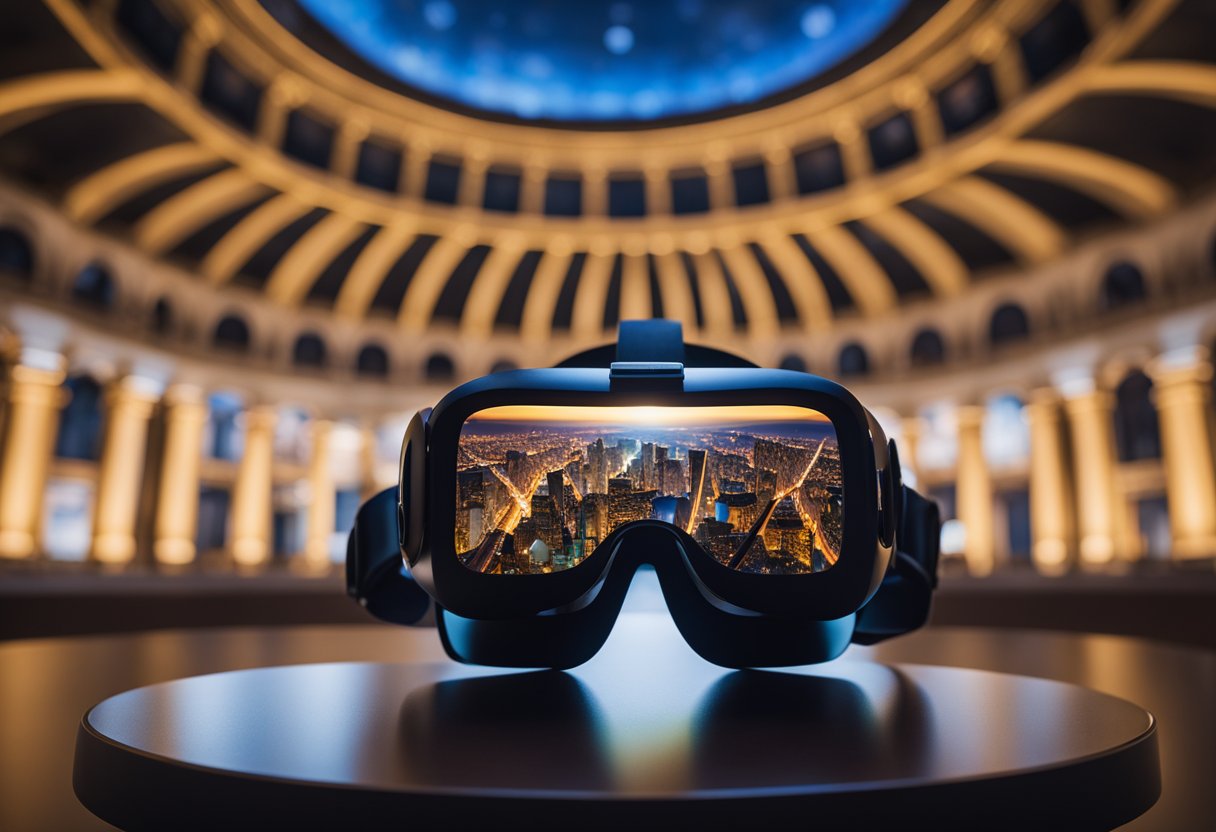Embracing Virtual Tours: The Rise of VR in Accessing Global Heritage Sites!

Updated On: April 20, 2024 by Esraa Mahmoud
The world of virtual reality (VR) has opened a new dimension for cultural exploration, transcending the physical limitations of travel and distance. Through VR, enthusiasts can venture into digitally reconstructed realms of the world’s cultural sites from the comfort of their own homes. This technological marvel brings a plethora of famous museums, historical landmarks, and sites of significant cultural heritage to a global audience, thus enhancing accessibility and fostering cultural understanding.

The integration of artificial intelligence (AI) with VR further personalises the experience, allowing for interactive and responsive tours that adapt to the preferences and interests of users. These evolving technologies not only democratise access to culture and knowledge but also serve as a powerful educational tool. Learners of all ages can witness history in vivid detail and gain a deeper insight into the art, traditions, and stories of people across the world.
The Evolution of Virtual Reality
Virtual reality (VR) has undergone a remarkable transformation, developing from a niche technology to a major platform for immersive experiences. We’ll explore how VR has evolved, focusing on its history, technological advancements, and diverse applications.
Historical Context
VR’s origins trace back to the mid-20th century, but it wasn’t until the emergence of products like Oculus Rift that the technology began to reach a wider audience. Initially seen as a form of entertainment, VR has branched out to deliver compelling experiences across various sectors.
Technological Advancements
Advances in graphics processing, motion tracking, and display technology have turned VR into a powerful tool. Contemporary virtual tours now offer a level of realism and interactivity that was once unimaginable. These advancements have been crucial in pushing VR from the realm of gaming into broader applications.
From Gaming to Education
Moving beyond gaming, VR now facilitates immersive virtual tours that allow users to visit cultural sites from the comfort of their homes. This has revolutionised education, enabling students to explore historical landmarks and World Heritage sites without being physically present, making the learning experience both accessible and engaging.
Virtual Tours and Their Impact on the Travel Industry
Embracing the digital transformation of the travel industry, virtual tours have become a dynamic vehicle, propelling cultural sites into the homes of millions globally. These immersive experiences present both economic opportunities and environmental considerations for the industry.
Economic Implications
Virtual tourism has injected new vitality into the travel industry, especially in light of restrictions due to COVID-19. Attractions that once relied on physical footfall have found a lifeline in the digital realm, with institutions such as museums and historical sites developing virtual tours to maintain engagement.
Life-like experiences, from virtual reality explorations to 360-degree video tours, enable these sites to continue generating revenue while their doors may be physically closed to visitors. This switch to digital has underscored the potential for virtual tourism to become a significant and long-term revenue stream within the travel industry.
Pioneering examples, such as the use of virtual reality to experience remote and heritage-rich locations, can be seen through the innovative approaches adopted by various stakeholders, as mentioned in Sage Journals.
Sustainability and Environment
The growth of virtual tours also brings sustainability into sharp focus, highlighting the positive environmental impact of reduced travel. Virtual tourism significantly lowers the carbon footprint associated with global travel, as it circumvents the need for transportation and lessens the tourist load on natural and cultural sites, thereby aiding in preservation efforts.
This shift champions the ideals of responsible tourism, which is critical in an era defined by climate challenges and environmental awareness. Analysis of virtual tourism’s role in a sustainable travel future is elaborated upon in discussions like those found at McKinsey & Company.
Integrating Virtual Reality with Art and History

In an age where the digital realm offers new possibilities, we’ve witnessed the remarkable amalgamation of virtual reality (VR) technology with the fields of art and history. Through this union, cultural heritage is not only being preserved but is also being revived and made accessible to a global audience.
Preservation of Cultural Heritage
Cultural institutions are increasingly harnessing VR to document and conserve the world’s artistic and historical patrimonies. For instance, detailed digital reconstructions allow us to experience architectural marvels as they once were.
Museums deliver these virtual encounters, providing a dynamic avenue for cultural preservation and education. VR acts as a bridge, transporting us across temporal boundaries and engaging us with cultural narratives in powerful, immersive ways.
Reviving Historical Sites
The revival of historical sites through VR isn’t mere reconstruction; it’s a reanimation of the past. Our experience of history is enriched as we virtually wander through ancient streets or stand amidst the digitally restored ruins of a long-lost temple.
Museums and historical sites adopt these techniques to offer us an unparalleled dive into history, thereby fostering a deeper understanding and appreciation for our collective heritage. By doing so; they strive to kindle interest in cultural conservation and generate a sense of responsibility towards our historic environments.
Through both preservation and revival, VR is opening the doors to the world’s cultural sites, allowing us not only to see but also virtually to step inside the tapestries of art and history.
Virtual Access to World-famous Museums and Sites
In an era where digital technology reigns, we now have the privilege of exploring some of the world’s most esteemed cultural sites from the comfort of home. Virtual tours allow unparalleled access to these iconic landmarks, offering a detailed and immersive experience.
British Museum
The British Museum, located in the heart of London and home to a vast collection of world art and artefacts, provides an exceptional virtual tour. Visitors can traverse the Great Court and delve into the history of the Rosetta Stone and the museum’s extensive Egyptian mummy collection, making this one of the UK’s most visited online museum experiences.
Colosseum of Rome
Rome’s illustrious Colosseum, a symbol of historical architectural prowess, is also accessible virtually. This iconic amphitheatre, which once witnessed the grandeur of ancient Roman spectacles, now opens its doors to global virtual visitors, showcasing the grandiosity of its arches and the remnants of its battleground.
Sanctuary of Delphi
Visitors can also journey to Greece and explore the Sanctuary of Delphi, revered as the ‘navel of the world’ in ancient times. The online journey through this archaeological wonder provides insights into its role as a cultural and religious centre, where the oracle once communicated Apollo’s divine words.
Evolving Technologies in VR and Their Use in Virtual Tours
Virtual reality continues to transform how we interact with cultural sites globally. The integration of AI and advancements in VR hardware are key to these developments.
Role of AI in Enhancing VR
Artificial Intelligence (AI) is instrumental in creating immersive virtual tours that provide a deeply engaging experience. By processing vast amounts of data, AI algorithms can suggest tailored tours based on individual preferences. This customisation ensures that each virtual visit is unique, learning from user interactions to improve suggested pathways through iconic landmarks. Moreover, AI can also animate historical figures or events, making the experience more informative and lifelike.
For instance, you can step back into ancient times or explore cultural heritage from the comfort of your home. AI’s capacity for complex simulations creates an environment where one can interact with the recreated past, such as virtually walking through the ruins of an ancient civilisation, now vividly restored to its former glory.
The Hardware Behind VR
Advancements in VR hardware have been pivotal in bringing virtual tours into mainstream use. Modern VR headsets, such as Oculus Rift, are more than just visual devices. They’re equipped with motion tracking, hand controllers, and auditory feedback, collectively working to simulate reality. This multi-sensory input is crucial for an immersive experience of global cultural sites.
Companies like Google have pushed the envelope by providing accessible VR experiences through platforms like Google Street View, which, when paired with VR hardware, allows users to explore locations around the world in 360 degrees. This has made it possible for people to visit historical sites, museums, and galleries, offering a different perspective on global culture without leaving their homes.
Enhancing Accessibility Through Virtual Reality

Virtual Reality (VR) is revolutionising the way we access cultural sites. It tears down physical barriers, enabling a more inclusive and educational experience for a diverse audience.
Inclusivity in Tourism
The advent of VR in the tourism industry has been instrumental in making the experience of exploring cultural sites more inclusive. Visitors with mobility impairments often find themselves limited by inaccessible terrain or structures.
They can now virtually explore sites like Mount Everest, which were previously deemed unreachable. VR serves as a powerful tool that allows everyone, irrespective of physical capabilities, to engage with the world’s heritage and wonders.
Virtual Learning
Virtual learning environments bring historical events and sites into classrooms or homes, offering an immersive experience that enhances educational outcomes. Through interactive elements and lifelike environments, we can facilitate deeper connections with the past and foster a global appreciation for our cultural heritage. By designing accessible VR experiences, we are also paving the way for a more inclusive learning future.
Through VR, we unlock a world where everyone has the opportunity to explore and learn without physical limitations, promoting a greater understanding of our rich, shared heritage.
The Role of VR in Education and Cultural Understanding

Virtual reality (VR) technology is revolutionising the way we approach education and cultural understanding. By enabling immersive virtual tours, VR enhances interactive learning and facilitates global outreach, making cultural sites more accessible than ever before.
Interactive Learning Experiences
With VR, students and enthusiasts alike gain the ability to explore historical sites and cultural artefacts in vivid detail without leaving their classrooms or homes. These interactive learning experiences are not confined to passive observation; they are dynamic and engaging, allowing exploration from multiple angles and providing a multisensory approach to education.
Educational programmes utilising virtual tours enable a deeper immersion into the subject matter. For example, one can ‘visit’ the Louvre and view the Mona Lisa up close or ‘walk’ through the ruins of ancient Rome, gaining insights that traditional textbooks can’t offer. This hands-on method in education cultivates a more profound cultural awareness and appreciation amongst participants.
Global Outreach
VR also expands global outreach by breaking down geographical barriers. Institutions can share their cultural wealth with a much broader audience, including individuals who might never have the opportunity to travel to these sites in person. This fosters a sense of global community and mutual understanding of diverse cultural heritages.
By allowing people from around the world to ‘experience’ remote locations and cultures, virtual tours promote an inclusive understanding of our global heritage. We’re seeing platforms like www.connollycove.com leverage the power of digital media to offer rich, cultural narratives that were previously inaccessible to many. Through VR, they support sustainable tourism, highlighting the importance of respecting and preserving the uniqueness of our world’s cultural sites while providing educational value.
Optimising Virtual Reality for User Experience

To fully harness the potential of virtual reality in cultural exploration, we need to pay close attention to sensory immersion and user interface.
Sensory Immersion in VR
Virtual reality thrives on stimulating the five senses to create a compelling sense of presence in a digital world. By optimising audiovisual feedback in a VR headset, we can transport users to cultural sites with stunning realism. Soundscapes that replicate the acoustics of historic halls or the chatter in a bustling market square enhance the experience. Utilising haptic feedback that corresponds with visuals deepens the tactile engagement, making the journey through virtual realms more immersive.
User Interface in VR
For optimal user experience within VR, the interface should be intuitive, minimising the learning curve and allowing users to navigate cultural sites with ease. Clear and responsive menus, iconography that is immediately recognisable, and gesture controls that mimic natural movements contribute to a user-friendly environment. By streamlining interaction, we allow users to focus on the content—be it ancient ruins or modern art galleries—fostering a more profound connection with the virtual tour.
The Significance of Accuracy and Realism in Virtual Tours

In virtual tours, the replication of historical settings with attention to detail enhances the overall experience, increasing user engagement and educational value.
Recreating Historical Accuracy
We understand that when historical sites and artefacts are reproduced with accuracy, users receive a more authentic encounter, as though they are stepping back in time. Our recreations of architecture and history consider the minutiae—from the texture of materials to the ambient sounds of the era. This diligence in reconstruction supports a more immersive learning environment.
Challenges in Virtual Recreation
Despite our aspiration for realism, we face challenges in virtual recreation. The balance between high-fidelity graphics and system performance is delicate—detailed models of historical architecture require extensive resources to render.
Additionally, ensuring the factual precision of historical narratives is paramount to retaining the integrity of the history they represent. We navigate these complexities tirelessly to bring reliable and compelling experiences to users everywhere.
Looking Ahead: The Future of Virtual Travel and Tourism
The travel industry is at the cusp of a significant transformation brought on by advancements in virtual reality (VR) technology. As we look to the future, virtual travel stands out as a promising trend, poised to provide enthusiasts with panoramic glimpses of global culture and heritage directly from their homes.
Virtual travel affords a myriad of potential benefits:
- Accessibility: Those unable to travel due to various constraints will be able to experience distant locales virtually.
- Education: Enhanced learning experiences through immersive historical and cultural exploration.
- Conservation: Decreased foot traffic at vulnerable sites, aiding preservation efforts.
- Inclusivity: A broader audience can engage with global cultures without the barrier of travel costs.
Recent innovations in VR indicate a future where virtual tourism complements traditional travel. For instance, tourists might begin their journey with a virtual reconnaissance of Parisian streets, helping them plan real-world visits more effectively.
| Technology | Impact on Virtual Travel |
|---|---|
| Hyper-realistic graphics | More lifelike experiences |
| Haptic feedback | Tangible interaction with virtual environments |
| AI customization | Personalized tour experiences |
We envision a balanced ecosystem where virtual and real-world travel coexists, with VR enhancing rather than replacing physical trips. As the tech matures, a synergy between VR and traditional tourism could emerge, offering comprehensive, sustainable tourism models.
Moving forward, we anticipate VR shaping the way we understand, appreciate, and experience the world’s cultural heritage. With hyper-real virtual tours, the vivid tapestry of humanity’s legacy can be explored in unprecedented depth, paving the way for an enlightened approach to global tourism.
Frequently Asked Questions
In this section, we address common enquiries about the intersection of virtual reality (VR) and cultural tourism—focusing on how VR shapes experiences, its impact on heritage sites, and the nuances of creating VR content for cultural exploration.
In what ways is virtual reality transforming global cultural exploration?
Virtual reality is revolutionising property viewing and global cultural exploration by allowing users to visit distant landmarks and experiences from anywhere in the world. It offers an accessible window into cultures and historical sites that many may not have the opportunity to visit physically, thereby broadening the audience for global heritage.
What roles does VR technology play in enhancing the tourism experience?
VR technology plays several roles in enhancing the tourism experience, including providing interactive and immersive previews of destinations, educating travellers about the significance of sites, and enabling remote exploration of locations that are either too fragile or inaccessible for mass tourism.
Are there any drawbacks associated with the use of virtual tours in place of physical travel?
There are some drawbacks associated with the use of virtual tours, such as the potential for a diminished sense of presence and the lack of physical interaction with the environment. It can’t replicate the full sensory experience of visiting a site in person, such as the sounds, smells, and tactile elements.
What impact does virtual tourism have on the preservation and accessibility of cultural heritage sites?
Virtual tourism positively impacts the preservation and accessibility of cultural heritage sites by facilitating virtual visits, thus reducing physical strain on the sites and allowing those with mobility issues or other constraints to enjoy and learn about global cultures.
How do virtual reality experiences compare to traditional methods of exploring cultural destinations?
Virtual reality experiences can offer detailed and immersive explorations that complement traditional methods. However, they often lack the personal, spontaneous interactions and the atmospheric nuances that are unique to physical travel.
What considerations must be taken into account when developing VR tours for cultural sites?
When developing VR tours for cultural sites, it’s crucial to consider the authenticity of the representation, the protection of sensitive information, and the potential impact on the local community and cultural perceptions. Stakeholder engagement and respecting the narrative of the site are imperative.






